The 18th International Architecture Exhibition entitled “The Laboratory of the Future” curated by Lesley Lokko, organized by the Venice Biennale, offers an incredible amount of proposals to change the world. They range from the simplest, such as that of the Niger pavilion, present for the first time, the island of San Servolo, entitled “Archifusion” to the most utopian and surprising, such as the one in the Central Pavilion at the Gardens. In the Force Majeure section, a large space is dedicated to Olalekan Jeyifous with his installation, ACE/AAP, which explores the local, transnational and diasporic harmonies and tensions of an eco-African retrofuturist fiction set in the alternate timeline of the year 1X72. “The Laboratory of the Future” is an exhibition divided into six parts, with 89 participants, more than half of whom come from Africa or the African diaspora. It begins in the Central Pavilion, where 16 studies representing a distillate of force majeure of African and diasporic architectural production have been brought together. We then have the Dangerous Liaisons section in the Arsenale complex, in Forte Marghera, and in Mestre – alongside that of the curator’s Special Projects. Then we have Guests from the Future, whose work directly compares with the two themes of the exhibition. In the Central Pavilion there are the works of some of the most representative practitioners active today, Africans and from the African diaspora, of which Olalekan Jeyifous is part with his project set, using digital media and experimental videos, in a abstract “port”, a sort of waiting room.
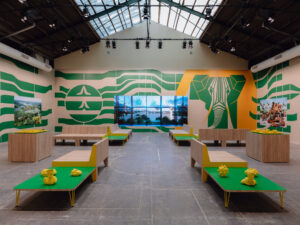
Olalekan Jeyifous, ACE/AAP, Central Pavillion at Giardini, section Force Majeure. Courtesy: La Biennale di Venezia
The artist imagines his own world where, in the wake of the Pan-African movement and African decolonization, the imperialist infrastructures dedicated to economic exploitation and resource extraction have been dismantled, while local environmental groups have consolidated into an African Conservation Effort (ACE), using indigenous knowledge to repair the ravages of the colonial era. We start from the reflection on the themes of decarbonization and decolonization, as indicated by the curator, to go further, imagining a huge revenge against the West. And here is the motivation of the award given to the artist: «Silver Lion for a promising young participant in the The Laboratory of the Future exhibition at Olalekan Jeyifous for a multimedia installation that explores a world-building practice capable of broadening the audience’s perspectives and imagination, offering visions of a decolonized and decarbonised future». As for utopias, in the French Pavilion a spherical installation – a spherical theater, covered with a layer of silver aluminum – Ball Theater © Muoto + Stanishev et La Sagna hosts a stage where artists and audiences can interact. It is an immersive and experimental place for celebration and discussion. Even regaining a space to play basketball is utopian for the Mexican Pavilion, entitled Utopian Infraestructura.
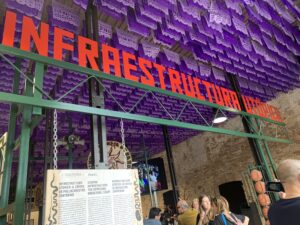
Mexican Pavillion, Infraestructura Utopica. Ph. Emanuele Magri
It is also utopian to break through the walls to connect two adjacent pavilions, such as that of Switzerland, dominated by the giant carpet that shows the floor plan of the Giacometti Pavilion and that of Scarpa, and that of Venezuela, He’s in the renovation business. In the same vein, the project to make the Venetian community accessible, through a bridge proposed by the Austrian Pavilion, the Biennale and the Sant’Elena district. No less projected into the future is the Luxembourg Pavilion, transformed into a lunar laboratory, in which there is space Down to Earth, the project by Francelle Cane and Marija Mari, which shows a performance of extraction of minerals and rare metals since the development of human settlements on the Moon. A purely political discourse, sometimes poised between reality and imagination, is that of the Australia Pavilion, in which Unsettling Queenstown highlights Australia’s colonial heritage at the end of the Second Elizabethan Era, treating Queenstown as an emblem of the decolonizing struggle around the world. Between real and fictional versions of Queenstown, the exhibition explores and questions the relationships between people and the environment under the logic of colonialism and resource extraction. The China Pavilion, present in the Dangerous Liaisons section at the Arsenal Corderie, with the installation Investigating Xinjiang’s Network of Detenction Camps by Killing Architects addresses the thorny subject of detention camps in Xinjiang and, as a result of the violation of human rights and the reaction of the Chinese authorities. In the Polish Pavilion, on the other hand, the possibility of new technologies proposing solutions for any problem is questioned, as demonstrated by the skeletons of four houses made in 1:1 scale.
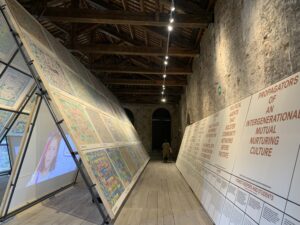
Peruvian Pavillion, Walkers in Amazonia. Ph. Emanuele Magri
Suspended between material and immaterial dimension is the National Pavilion of Saudi Arabia, which presents the IRTH إرث project (“legacy” in Arabic), conceived by the architect AlBara Saimaldahar, founder and creative director of the design studio Dahr, located in Jeddah, and curated by two sisters Basma and Noura Bouzo, co-founders of &bouqu, creative and cultural consulting company of Riyadh. Infinite variations are proposed from the archive in the form of a recipe book by the Spanish Pavilion to that of Uruguay, which is a laboratory for the future of wood as a material, involving music, visual culture and architecture. Uzbekistan, with Unbuild Together: Archaism vs. Modernity, draws on architectural heritage to imagine its own future and challenge the concept of modernity. Particularly interesting is the Pavilion of Great Britain, entitled Dancing Before the Moon, which addresses the theme of diaspora architecture through the pre-colonial lens, celebrating the architectural varieties with various amazing installations, like that of Yussef Agbo-Ola, born in rural Virginia in a family at the same time Nigerian, African American and Cherokee, which presents with Muluku 6 Bone Temple a set of organic cotton skins, inspired by the traditional architectural elements of the Yoruba and Cherokee cultures. They are embroidered motifs that reflect the cosmological belief systems of these cultures. It could only be connected with its dramatic present, however, the Ukrainian Pavilion at the Arsenale (in the Sala d’Armi) with a dark space, symbol of abandoned places that can become vital places to plan the future.
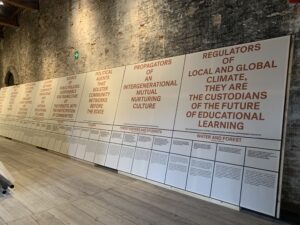
Peruvian Pavillion, Walkers in Amazonia. Ph. Emanuele Magri
On the other hand, intervention in reality with practical projects, even simple ones, was cited as an example the Niger Pavilion, with Commissioner Souleymane Ibrahim and the curatorship of Boris Brollo who states: In ARCHIfusion the concept of collaboration in the broadest sense of an enlarged “workshop/laboratory” is deepened”. Here we find the Brique Magique, a brick, “reformed” by the architectural firm Mauro Peloso, which can always be packaged in raw earth, but with internal holes and a different shape, with the possibility of building walls of greater thickness with the same material used. That of the Pavilion of Peru is a project of collective management of the territory of the department of San Martín, in which representatives of the indigenous communities Kichwa, Awajún and Shawi, those mestizos and educational institutions of the provinces of El Dorado, Lamas and San Martín are committed to building a bond between community, school and territory. With Walkers in Amazonia the Pavilion presents 64 community calendars that give visibility to a contemporary phenomenon of collective resistance in the struggle for indigenous and civil territorial rights, highlighting a technology that risks disappearing and that enhances and reinvents ancestral practices. It is a reflection on climate change, deforestation, the environmental degradation of the Amazon forests and intercultural loss, with a call for action.

Niger Pavillion, ARCHIfusion, set up ^SEQN^. Ph. Luca Casonato
Finally, the collective Fosbury Architecture, formed by Giacomo Ardesio, Alessandro Bonizzoni, Nicola Campri, Veronica Caprino, Claudia Mainardi, curates the Italian Pavilion at the Tese delle Vergini at the Arsenale, with the support of the Directorate General for Contemporary Creativity of the Ministry of Culture. Nine site-specific interventions in as many places selected throughout the Italian territory, characterized by the first phase – Spaziale presents – preparatory to the second phase. The title of the exhibition is Spaziale. Everyone belongs to everyone else.
Info:
18th International Architecture Exhibition of Venice
20/05/2023 – 26/11/2023
Venice

Emanuele Magri teaches History of Art in Milan. Since 2007 he has been writing abroad for Juliet art Magazine. Since the 1970s he has dealt with writing and visual arts. He created taxonomically defined worlds, in which he experimented with the self-referentiality of language, such as “La Setta delle S’arte” in which ritual clothes are made starting from words with multiple meanings, the “Treaty of genetic art” in which a series of plants is obtained from grafts of human organs, eyes, hands, mouths, etc., and the project “Fandonia”, a city where everything is double and hybrid.


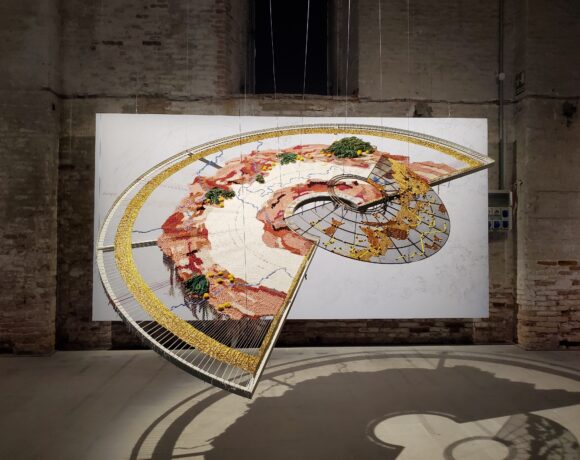
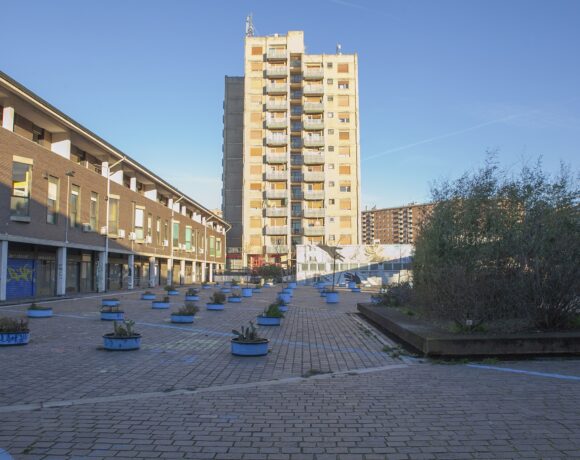
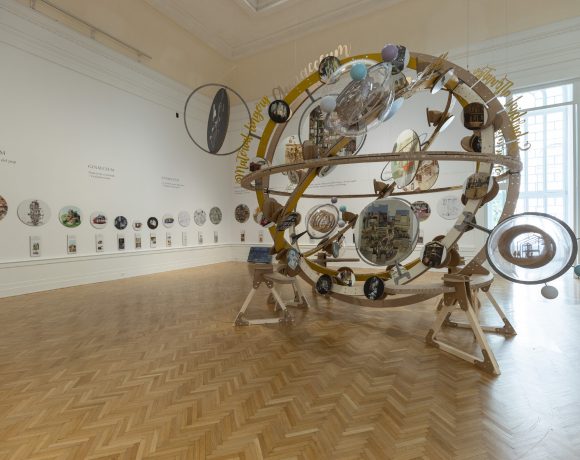

NO COMMENT